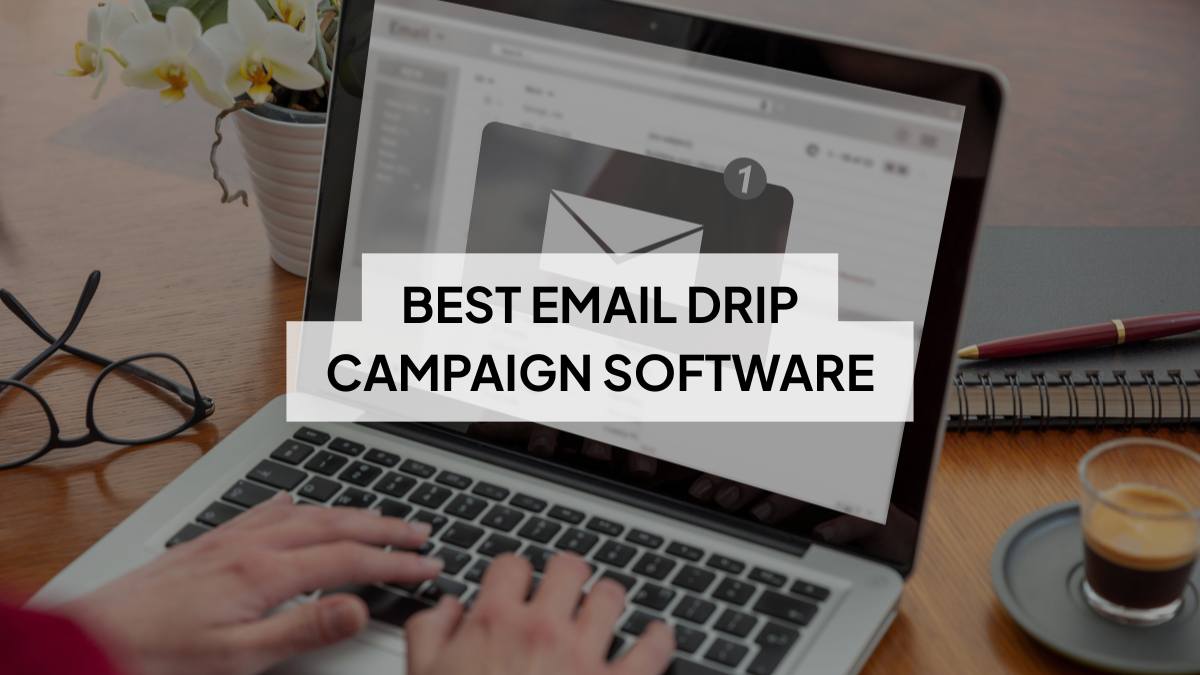The best email drip campaign software is less about big promises and more about making your life easier. These tools basically let you set up emails that go out on their own – welcomes, follow-ups, reminders – without you sitting there hitting send. ActiveCampaign is a favorite for advanced automation, HubSpot is great if you want everything under one roof, and Mailchimp still works fine for beginners. Creators usually lean toward ConvertKit, while eCommerce folks get the most out of Drip. Brevo is the budget pick. In the end, the best choice depends on your goals, your list size, and honestly, your patience.
Table of Contents
Introduction: Why Email Drip Campaign Software Matters
Running email by hand is fine for the very beginning. Then one week later, you’ve got a list, and two weeks later, you have to remember who got which follow-up. It gets chaotic fast.
Drip campaign software fixes that. Not magic, just practical: set up a welcome series, follow with product tips, and nudge inactive users later. It keeps things consistent without you babysitting every send. That consistency usually equals better opens and more conversions. Simple fact.
Also, picking the wrong tool? That will slow you down more than any sloppy copy. Some platforms feel great to use, but don’t scale. Others have every feature but are clunky. So yeah, tool choice matters as much as the emails themselves.
What is Email Drip Campaign Software?
Short version: it automates sequences of emails based on time or actions.
Examples, quick:
- New subscriber → welcome email immediately.
- Three days later → tutorial or product tip.
- If they don’t open → a different subject line or a re-engagement nudge.
That’s different from a one-off newsletter. A newsletter is a broadcast. Drip is a conversation over time. It reacts to behavior, cart abandonment, inactivity, downloads, and sends the right follow-up without manual effort. In practice, that’s how you move people through the funnel without losing them to inbox fatigue.
Key Features to Look for in the Best Email Drip Campaign Software
Not all bells and whistles matter. Focus on what helps you actually get campaigns out and improve them.
1. Automation & Workflows
You want a visual flow builder or something close to it. If you can’t map “if A then B, if not A then C” in a few clicks, it’s going to slow you down. Triggers, delays, conditional splits, those are the basics that decide how personalized your sequences can be.
2. Personalization & Segmentation
First-name tokens are fine, but real personalization goes deeper, behavior, purchase history, page views, location. Segment well and your open and click rates will thank you.
3. Integrations
Your email tool should talk to your CRM, your eCommerce platform, your analytics. If you’re exporting CSVs every week, that tool is a drain. Look for native integrations or solid APIs.
4. Analytics & Reporting
Open rates are just the start. Look for link-level tracking, conversion tracking, and cohort analysis so you can see which sequences actually lead to customers, not just clicks.
5. Ease of Use and Scalability
This one matters more than you might think. If it takes days to launch a simple welcome series, that tool is not working for you. And pricing, watch it. Some platforms look cheap at 1,000 contacts and then feel punishing at 10,000. Choose something that grows with you.
Also Read: Best WhatsApp Marketing Software Tools
Best Email Drip Campaign Software
Alright, here’s the part most people jump straight to, the actual tools. There’s no one-size-fits-all answer here. A freelancer running a small email list doesn’t need the same horsepower as a 50-person eCommerce team. So instead of ranking them in some fake “objective” order, let’s break down the ones that actually stand out and what they’re best at.
1. ActiveCampaign – Best Overall
If there’s one platform that consistently delivers for different kinds of businesses, it’s ActiveCampaign. The automation builder is powerful without being overwhelming. You can set up branching paths, conditional triggers, and all the nerdy stuff if you want, but it’s still intuitive enough to get started.
What makes it shine: the CRM built right in. That means your sales team and your email automations actually talk to each other. For businesses that care about lead scoring, pipelines, and nurturing customers over months, this is gold.
Downside? It can get pricey as your list grows, and if you only want barebones drip campaigns, it might feel like overkill.
2. HubSpot – Best for All-in-One Marketing
HubSpot isn’t just email, it’s your CRM, your blog, your landing pages, your ad tracking, all tied together. That’s both its strength and its weak spot.
If you’re the kind of business that wants everything under one login, it’s fantastic. Your drip emails can pull directly from your CRM data, so personalization is next-level. You can trigger emails off of almost any interaction: a deal stage change, a form fill, a call logged by sales.
But, fair warning: HubSpot gets expensive. The free tier is fine for testing, but the real automation power sits behind higher plans.
3. Mailchimp – Best for Beginners
Mailchimp has been around forever, and honestly, that shows in both good and bad ways. It’s incredibly user-friendly. The interface is clean, and you can have a simple drip campaign running in under an hour.
Great for small lists, side projects, or creators who just want to send welcome sequences and basic follow-ups. The templates are polished, and you don’t need to be technical to make something look professional.
Where it falls short is advanced automation. If you want complex branching or multi-channel triggers, you’ll quickly hit limits. But for simple sequences? Still one of the easiest out there.

Apply Now: AI Marketing Course
4. ConvertKit – Best for Creators and Course Sellers
ConvertKit built its reputation with bloggers and creators, and it shows. The automation is visual and straightforward, but the real strength is tagging and segmentation. You can send different sequences depending on whether someone downloaded a lead magnet, purchased a course, or just joined your list yesterday.
It integrates well with digital product tools (think Gumroad, Teachable, Shopify lite stores). If you’re selling knowledge or content, this is a strong pick. Pricing is fair too, scaling predictably as your list grows.
The limitation? It’s not as feature-heavy for large, complex sales teams. It’s built for creators first.
5. Drip – Best for eCommerce
The name says it all. Drip was made for online stores. It plugs into Shopify and WooCommerce seamlessly, so you can set up abandoned cart flows, product recommendations, post-purchase upsells, basically all the campaigns that make money for eCom.
The reporting is very focused on revenue attribution, not just opens and clicks. That’s something a lot of eCommerce marketers care about more than vanity metrics.
The platform itself is clean but does lean more toward marketers who already know what they’re doing. If you’re brand new, the setup may feel a bit advanced.
6. Brevo (formerly Sendinblue) – Best Budget Option
Brevo keeps things simple and affordable. Pricing is based on email volume, not list size, which is a lifesaver for businesses with big lists that don’t mail daily.
It handles email and SMS automation, which is rare at this price point. The drip sequences are solid, nothing too flashy, but enough to cover most small to midsize business needs.
The trade-off? The interface isn’t as polished as some of the bigger names. But if cost is a deciding factor, Brevo gets the job done without bleeding your budget.
Also Read: Best SMS Marketing Software Tools
Quick Takeaway
Each tool has its lane.
- ActiveCampaign – businesses needing serious automation + CRM.
- HubSpot – teams that want everything in one system.
- Mailchimp – beginners or small lists.
- ConvertKit – creators, bloggers, course sellers.
- Drip – eCommerce, hands down.
- Brevo – affordable and versatile for lean teams.
The best approach? Test the free trials. Nothing replaces logging in, clicking around, and seeing if it “feels right” for your workflow.
Also Read: Top Online Reputation Management (ORM)Tools
How to Choose the Best Email Drip Campaign Software for Your Business
Here’s the tricky part: no tool is universally “the best.” What works perfectly for one team might frustrate another. The decision comes down to a few practical questions.
1. Match the Tool to Your Business Type
- Small businesses or solo creators: You don’t need enterprise-level features. Tools like Mailchimp or ConvertKit will save you money and headaches.
- eCommerce stores: Skip the generic platforms. Drip is purpose-built for abandoned carts, product recommendations, and revenue tracking.
- Growing agencies or sales teams: ActiveCampaign or HubSpot are worth a look. They combine marketing with CRM features, which keeps sales and marketing aligned.
2. Budget vs. Features
A lot of tools look cheap at first, but costs rise fast with list size. Always run the math: 1,000 subscribers, 10,000 subscribers, 50,000 subscribers. Make sure your budget can handle scaling.
3. Ease of Use Matters More Than You Think
Fancy dashboards don’t equal better results. If your team dreads logging in, campaigns won’t get built. Sometimes the “simpler” tool ends up being the smarter long-term choice.
4. Think About Growth
Switching platforms mid-growth is painful. Imports, exports, broken automations, it’s not fun. Better to choose something that might stretch with you for the next few years, even if you don’t use every feature right away.
Also Read: 30 Keyword Research Tools for Every Use Case
Conclusion
The right tool depends less on “which one is the most popular” and more on where your business is right now.
- Want simplicity and speed? Mailchimp or Brevo are solid bets.
- Selling courses or digital products? ConvertKit makes the process smoother.
- Running an eCommerce store? Drip is built for you.
- Need advanced automation or a tight CRM integration? ActiveCampaign or HubSpot will carry the weight.
The smartest move is to test two or three with free trials. Click around, build a quick sequence, and see which one feels natural. The difference between a tool you enjoy using versus one you fight with every week is night and day.
And once you’ve picked your platform, the real work begins: crafting emails people actually want to read. The software just delivers them; the strategy and content are what make the campaigns work.
FAQs: Email Drip Campaign Software
What is the best free email drip campaign software?
Brevo (formerly Sendinblue) has one of the strongest free plans if you want automation without spending a dime. Mailchimp also offers a free tier, though it’s limited once your list grows. For small projects, either works.
Which software has the best automation features?
ActiveCampaign is tough to beat for pure automation power. You can build complex, branching workflows without needing a developer. HubSpot is also strong, but you’ll pay more for those features.
Is Mailchimp good for drip campaigns?
Mailchimp is fine for simple drip sequences like a welcome flow or a re-engagement series. If you want advanced triggers or detailed personalization, you’ll probably outgrow it.
What’s the difference between drip campaigns and triggered emails?
A drip campaign is usually a planned sequence that goes out over time (welcome, follow-up, reminder). Triggered emails fire off based on a specific action, like a cart abandonment email the moment someone leaves without purchasing. They overlap, but drip campaigns are more about the long game.

